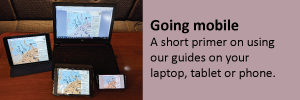Sweating the Swinomish

Looking back on the Rainbow Bridge from La Conner. (Photo by Mark Pouley)
Kody Skvaril is well versed on the issues. He’s the harbormaster at La Conner Marina, the large Port of Skagit facility on the channel, and it doesn’t much matter how enchanting the comforts his marina crew provides, how clean the toilets, how well maintained the floats, their work is trumped by chilling anecdotes that keep many boaters away.
“This is the biggest issue we deal with at the marina,” he laments. While Skvaril admits the channel has it’s challenges, “the majority of regional boaters are frightened of the Swinomish Channel, mainly because of the horror stories.”
Skvaril is planning to put together a photo tutorial to help address these concerns.
Googling brings stories to the surface, the groundings, the collisions, the little old lady who didn’t know ‘red right returning’ from ‘splice the main brace’ (and, yes, one of them does involve the consumption of alcohol).
Not only is the channel narrow, with maniacs all around who force you aground, but once you are tied to a dock, a mad skipper in a murderous barge will come along to ram you.
And of course we’re having fun, more fun than we might have if I had been hit by someone who didn’t know, when the sea is flowing, to motor into the current when docking.

Fields of Tulips just east of the Swinomish Canal. (Photo by Larry Jacobson)
The fact is, if you take things slow, don’t stray outside the well-marked channel and respect currents, transiting the lovely channel is a breeze.
There are issues. Current and tide forecasts are only approximate. The lack of precision involves amphidromics and bathymetry that are well beyond my pay grade, but it is simple enough to time your passage for a gentle, favorable flow.
Using Seattle tide tables (and adding 30 minutes to the times), currents flow north for 2.5-4 hours before and 2.5-4 hours after high water, and flow south for 2.5-4 hours before and after low water. Slack water is 2.5-4 hours after high or low water.
As well, the navigation marks are right-red-returning at both ends of the channel. The colors flip sides at La Conner, which seems to confuse some boaters.
And south of La Conner, from the entrance of Shelter Bay to the community’s southernmost house, deep-keeled vessels should slightly favor the east side of the channel at low water.
Skvaril is often asked questions about channel depths at the south end. He begins his replies by discussing the importance of using the range markers in Dugualla Bay to guide a vessel’s entrance. He soon realizes that many questioners are unfamiliar with using such crucial navigational aids.
By necessity, his answers sometimes become a bit of a seminar.
(The Swinomish Channel is covered in Salish Sea Pilot’s Cruising Guide to Puget Sound.)


















